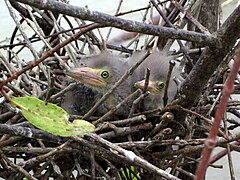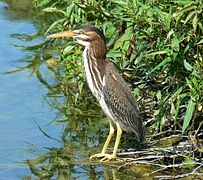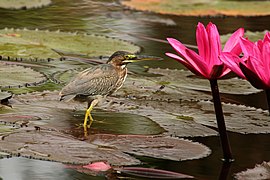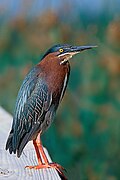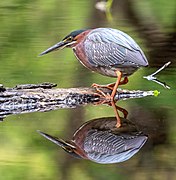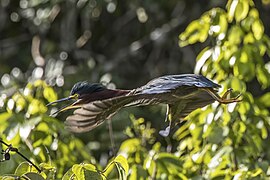Green heron
| Green heron Temporal range:
| |
|---|---|

| |
| Green heron have iridescent green feathers on their wings | |
| Call | |
| Scientific classification | |
| Domain: | Eukaryota |
| Kingdom: | Animalia |
| Phylum: | Chordata |
| Class: | Aves |
| Order: | Pelecaniformes |
| Family: | Ardeidae |
| Genus: | Butorides |
| Species: | B. virescens
|
| Binomial name | |
| Butorides virescens | |

| |
| Range of B. virescens Breeding range Year-round range Wintering range
| |
| Synonyms | |
|
Ardea virescens Linnaeus, 1758 | |
The green heron (Butorides virescens) is a small heron of North and Central America. Butorides is from Middle English butor "bittern" and Ancient Greek -oides, "resembling", and virescens is Latin for "greenish".[2]
It was long considered
Description
The green heron is relatively small; adult body length is about 44 cm (17 in). The neck is often pulled in tight against the body. Adults have a glossy, greenish-black cap, a greenish back and wings that are grey-black grading into green or blue, a
The green heron's call is a loud and sudden kyow; it also makes a series of more subdued kuk calls. During courtship, the male gives a raah-rahh call with wide-open bill, makes noisy wingbeats and whoom-whoom-whoom calls in flight, and sometimes calls roo-roo to the female before landing again. While sitting, an aaroo-aaroo courtship call is also given.[5][6]
Measurements:[7]
- Length: 16.1–18.1 in (41–46 cm)
- Weight: 8.5 oz (240 g)
- Wingspan: 25.2–26.8 in (64–68 cm)
Taxonomy
As noted above, this species was formerly included in B. striata, which at that time was erroneously known as B. striatus. The Early Pleistocene B. validipes, whose fossil remains were discovered in Florida, might have been the ancestor of the green heron as the living species seems to replace the extinct relative in the fossil record.
Subspecies distinction is uncertain at best. The color variation between populations is less pronounced than between birds of the same population. Migratory populations are longer-winged than those resident year-round, but this cannot be used to delimit subspecies as it is quite obviously a consequence of differing habits and can be expected to undergo
The following subspecies are commonly listed, though the validity of most of them is seriously disputed:[4]
- Butorides virescens anthonyi (Mearns, 1895)
- Breeds in the United States west of the Baja California Peninsula, Mexico. Some resident, most migrate to western Mexico in winter.
- Butorides virescens bahamensis (Brewster, 1888)
- Bahamas. Resident.
- Butorides virescens frazari (Brewster, 1888)
- Southern Baja California Peninsula, Mexico. Resident.
- Southernmost US through Central America to central Panama, Caribbean. Resident.
- Breeds from southeastern Canada to central and southern US east of the Rocky Mountains. Winters from southernmost US to northern South America.
Much of the dispute hinges upon the distinctness of the Caribbean and Central American populations, the second
Ecology

The
The northern population moves to its breeding ranges during March and April; near the northernmost limit of the green heron's range, breeding is well underway by the end of May. The migration to the winter quarters starts in September; by late October, the birds are absent from regions where they do not stay all year. At least the northward migration does not seem to be affected by
Individuals of non-migratory populations abandon their territories after breeding season to roam about the region. They may or may not return to the previous year's breeding location, depending on whether they found better habitat during these wanderings. In these populations, the breeding season is determined by rainfall and consequent prey availability.[4][5][6]
Green herons are
The
Tool use
Green herons are one of the few species of bird known to use tools. In particular, they commonly use bread crusts, insects, or other items as bait. The bait is dropped onto the surface of a body of water to lure fish. When a fish takes the bait, the green heron then grabs and eats the fish.[17]
Gallery
-
Nestlings
-
Subadult retaining some juvenile plumage
-
Young adult B. v. virescens
-
Breeding plumage
-
Adult
-
Adult
-
Hunting in New York
-
in Guatemala
-
Subspecies B. v. maculata with neck extended
-
Juvenile, Glastonbury, CT USA
References
- ^ BirdLife International (2012). "Butorides virescens". IUCN Red List of Threatened Species. 2012. Retrieved 26 November 2013.
- ISBN 978-1-4081-2501-4.
- ^ "Rare green heron spotted in Llanmill, Pembrokeshire". BBC News. 30 April 2018. Retrieved 30 April 2018.
- ^ ISBN 84-87334-10-5
- ^ a b c d e f g h Cornell Lab of Ornithology. "Green Heron". Retrieved 2010-04-08.
- ^ a b c d e f g h Dewey, T. & Butzbaugh, J. (2001): Animal Diversity Web: Butorides virescens. Retrieved 2008-FEB-12.
- ^ "Green Heron Identification, All About Birds, Cornell Lab of Ornithology". www.allaboutbirds.org. Retrieved 2020-09-26.
- ^ "ITIS Report: Butorides virescens". Integrated Taxonomic Information System. Retrieved 28 August 2014.
- ^ a b Moore, Amanda A.; Green, M. Clay; Huffman, David G.; Simpson, Thomas R. (2016). "Green Herons (Butorides virescens) in an Urbanized Landscape: Does Recreational Disturbance Affect Foraging Behavior?". The American Midland Naturalist. 176 (2): 222–233.
- ^ a b "Butorides virescens (Green Heron)" (PDF). The Online Guide to the Animals of Trinidad and Tobago. University of the West Indies.
- ^ a b c "Butorides virescens (Green heron)". Animal Diversity Web.
- ^ a b Davis Jr., William E.; Zickefoose, Julie (1998). "Bait-fishing by Birds: A Fascinating Example of Tool Use". Bird Observer. 26 (3): 139–143.
- ^
Henninger, W.F. (1906). "A preliminary list of the birds of Seneca County, Ohio" (PDF). Wilson Bulletin. 18 (2): 47–60.
- ^ Ohio Ornithological Society (2004): Annotated Ohio state checklist Archived 2004-07-18 at the Wayback Machine.
- ^ Cornell Lab of Ornithology. "Green Heron". Retrieved 2011-05-11.
- ^ Seattle Audubon Society. "Green Heron". Archived from the original on 2016-03-04. Retrieved 2010-04-08.
- ^ "Green Heron Overview, All About Birds, Cornell Lab of Ornithology". www.allaboutbirds.org. Retrieved 2022-05-22.
External links
- Butorides virescens – Green heron at Animal Diversity Web
- Green heron – Butorides virescens – USGS Patuxent Bird Identification InfoCenter
- Green heron at eNature.com
- Field Guide on Flickr
- "Butorides virescens". Integrated Taxonomic Information System. Retrieved 9 February 2006.
- YouTube video of a green heron fishing
- YouTube Video of a Green Heron drowning a frog before eating it!
- Bermuda Dept. of Environment and Natural Resources green heron page
- "Green-backed heron media". Internet Bird Collection.
- Green heron photo gallery at VIREO (Drexel University)
- Green heron species account at Neotropical Birds (Cornell Lab of Ornithology)


